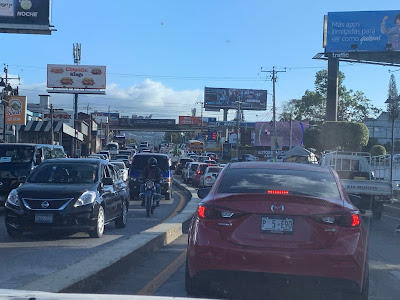Traffic report
You can spend a lot of time in El Salvador's cities in traffic, particularly in San Salvador. Growing number of vehicles on the roads in crowded cities produce rush hours which can seem to last throughout the day and challenge your ability to arrive on time.
On the one hand, the growth in the number of vehicles is a positive sign of a growing number of Salvadoran households able to afford car ownership. On the other hand, the country has to struggle with congestion and the need to adapt its street and highway system to the ever increasing vehicle total.
Here is a set of statistics about traffic in El Salvador:
1.5 million. That's the number of vehicles registered to drive on El Salvador's roads according to the vice minister of Transportation. That total includes slightly more than 1 million cars and 451 thousand motorcycles.
10 thousand. The number of additional vehicles which arrive in the country each month, the majority of them being used vehicles shipped from the US.
20.2%. Portion of Salvadoran households which own a car. (DIGESTYC-MINEC, 2020).
37 million hours. Annual quantity of delays caused by traffic congestion for drivers in San Salvador, equivalent to an average of 83 hours per year per car user. The InterAmerican Development Bank studied traffic congestion in 10 Latin American cities including San Salvador and published a report titled Urban road congestion in Latin America and the Caribbean: characteristics, costs, and mitigation. Those 83 hours per car driver ranked San Salvador 4th out of the 10 cities studied.
$25 million. The value of the time lost with those 37 million hours according to the IADB study.
 |
| No surprises here -- congestion by day of the week. |
1346. Number of traffic deaths on El Salvador's roads during 2021. This was down 3.6% from the total of 1396 deaths in 2020, and despite reduced traffic activity during pandemic lockdown periods in 2020. (Source).
18,587. Number of traffic accidents in El Salvador during 2021.
8. The number of real time traffic cameras you can watch at this site: http://eltraficosv.com/ if you want to see current traffic conditions in the greater San Salvador area.
The government is taking steps to try and get ahead of ever increasing congestion delays. There are plans to implement steps such as smart traffic lights at intersections, photo based traffic tickets, building additional bypasses and multi-level traffic circles. There does not seem to be any plan for mass transit systems to reduce automobile use.
These seem to be good steps, but it is difficult to say whether they can keep ahead of the every-growing number of Salvadoran cars and drivers.
***
These are my personal pet peeves for things which aggravate traffic congestion in El Salvador:
- Random stopping. Drivers in El Salvador seem to believe that if you just put on your hazard lights you can pretty much stop your car anywhere, even if you are largely blocking a lane of traffic.
- Food stands at busy intersections and traffic circles. We all need a snack or a tortilla sometime, but building stands at these intersections and making a sale to a car in traffic is a big bottleneck creator in some areas.
- Not clearing accidents from the road. A traffic accident in El Salvador is not cleared until the insurance adjusters arrive to investigate, even for a relatively minor fender bender. (In fact, my auto insurance policy doubles my deductible if I move my car). So even minor accidents can tie up traffic and create gridlock for an extended amount of time. (There is a proposal to promote just taking photos and then get the cars out of traffic).
- Lack of parking. San Salvador and the rest of the country's cities were not designed with parking in mind. That results in a tremendous amount of street parking which can eliminate one or more lanes from urban streets.
- Lack of parking enforcement. I suppose it's difficult to justify giving out lots of parking tickets if there really are no places to park.

Comments